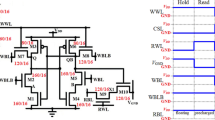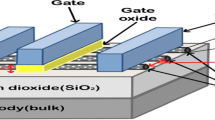Abstract
Low power consumption of electronic devices has become one of the most desirable factors in the present day’s technology. Static random access memory (SRAM) being an integral part of most of the electronic gadget suffers from leakage current which results in static power dissipation and subsequently affects its performance particularly during standby or hold mode. This becomes crucial especially for those systems which are portable and have limited power supply. This work therefore proposes a body bias controller implemented with a 7T SRAM cell at 28 nm CMOS technology node which lowers the static power consumption and increases the hold static noise margin (HSNM) of SRAM during standby mode by changing the threshold voltage. Moreover, it also reduces write delay due to reduction in threshold voltage of proposed design without having a significant effect on write static noise margin and read static noise margin. It has been noticed that there is a reduction of 40%, 28%, 41.9% and 30% in static power dissipation whereas there is an enhancement of 19%, 14.2%, 6.6% and 5.2% in HSNM of the proposed design when compared to 6T SRAM cell, 7T SRAM cell, WRE8T SRAM cell and 9T SRAM cell, respectively. The proposed design can thus be a suitable alternative for low power SRAMs.
















Similar content being viewed by others
References
K.I. Agawa, H. Hara, T. Takayanagi, T. Kuroda, A bitline leakage compensation scheme for low-voltage SRAMs. IEEE J. Solid-State Circuits 36(5), 726–734 (2001)
M. Blagojević, M. Cochet, B. Keller, P. Flatresse, A. Vladimirescu, B. Nikolić, A fast, flexible, positive and negative adaptive body-bias generator in 28 nm FDSOI, in 2016 IEEE Symposium on VLSI Circuits (VLSI-Circuits), Honolulu, HI, pp. 1–2 (2016)
B.H. Calhoun, A.P. Chandrakasan, A 256-kb 65-nm sub-threshold SRAM design for ultra-low-voltage operation. IEEE J. Solid-State Circuits 42(3), 680–688 (2007)
M.F. Chang, C.F. Chen, T.H. Chang, C.C. Shuai, Y.Y. Wang, Y.J. Chen, H. Yamauchi, A compact-area low-VDD min 6T SRAM with improvement in cell stability, read speed and write margin using a dual-split-control-assist scheme. IEEE J. Solid-State Circuits 52(9), 2498–2514 (2017)
L. Chang, D.M. Fried, J. Hergenrother, J.W. Sleight, R.H. Dennard, R.K. Montoye, L. Sekaric, S.J. McNab, A.W. Topol, C.D. Adams, K.W. Guarini, Stable SRAM cell design for the 32 nm node and beyond, in Digest of Technical Papers. 2005 Symposium on VLSI Technology, 2005, IEEE, pp. 128–129 (2005)
R.H. Dennard, F.H. Gaensslen, H.N. Yu, V.L. Rideout, E. Bassous, A.R. LeBlanc, Design of ion-implanted MOSFET’s with very small physical dimensions. IEEE J. Solid-State Circuits 9(5), 256–268 (1974)
N. Kamae, A. Tsuchiya, H. Onodera, A body bias generator with low supply voltage for within-die variability compensation. IEICE Trans. Fundam. Electron. Commun. Comput. Sci. 97(3), 734–740 (2014)
S.M. Kang, Y. Leblebici, CMOS digital integrated circuit (Tata Macgraw-Hill education, New York, 2003)
C.I. Kumar, B. Anand, Design of highly reliable energy-efficient SEU tolerant 10T SRAM cell. Electron. Lett. 54(25), 1423–1424 (2018)
C.B. Kushwah, S.K. Vishvakarma, D. Dwivedi, Single-ended boost-less (SE-BL) 7T process tolerant SRAM design in sub-threshold regime for ultra-low-power applications. Circuits Syst. Signal Process. 35(2), 385–407 (2016)
Y.C. Lai, S.Y. Huang, X-calibration: a technique for combating excessive bitline leakage current in nanometer SRAM designs. IEEE J. Solid-State Circuits 43(9), 1964–1971 (2008)
R. Lorenzo, S. Chaudhury, A novel 9T SRAM architecture for low leakage and high performance. Analog Integr. Circ. Sig. Process 92(2), 315–325 (2017)
J.K. Mishra, H. Srivastava, P.K. Misra, M. Goswami, Analytical modeling and design of 9T SRAM cell with a leakage control technique. Analog Integr. Circ. Sig. Process 101(1), 31–43 (2019)
J.K. Mishra, H. Srivastava, P.K. Misra, M. Goswami, A 40 nm low power high stable SRAM cell using separate read port and sleep transistor methodology, in IEEE International Symposium on Smart Electronic Systems (iSES) (Formerly iNiS), Hyderabad, India (2018)
M. Moghaddam, S. Timarchi, M.H. Moaiyeri, M. Eshghi, An ultra-low-power 9T SRAM cell based on threshold voltage techniques. Circuits Syst. Signal Process. 35(5), 1437–1455 (2016)
S. Naghizadeh, M. Gholami, Two novel ultra-low-power SRAM cells with separate read and write path. Circuits Syst. Signal Process. 38(1), 287–303 (2019)
M. Nobakht, R. Niaraki, A new 7T SRAM cell in sub-threshold region with a high performance and small area with bit interleaving capability. IET Circuits Devices Syst. 13(6), 873–878 (2019)
H. Okuhara, A.B. Ahmed, H. Amano, Digitally assisted on-chip body bias tuning scheme for ultra-low-power VLSI systems. IEEE Trans. Circuits Syst. I Regul. Pap. 65(10), 3241–3254 (2018)
S. Pal, A. Islam, Variation tolerant differential 8T SRAM cell for ultralow power applications. IEEE Trans. Comput. Aided Des. Integr. Circuits Syst. 35(4), 549–558 (2015)
G. Pasandi, S.M. Fakhraie, An 8T low-voltage and low-leakage half-selection disturb-free SRAM using bulk-CMOS and FinFETs. IEEE Trans. Electron Devices 61(7), 2357–2363 (2014)
M. Sharifkhani, M. Sachdev, Segmental virtual ground architecture for low power embedded SRAM. IEEE Trans. Very Large Scale Integr. (VLSI) Syst. 15(2), 196–205 (2007)
G. Torrens, B. Alorda, C. Carmona, D. Malagon-Perianez, J. Segura, S.A. Bota, A 65-nm reliable 6T CMOS SRAM cell with minimum size transistors. IEEE Trans. Emerg. Top. Comput. 7(3), 447–465 (2017)
B. Wang, T.Q. Nguyen, A.T. Do, J. Zhou, M. Je, T.T.H. Kim, Design of an ultra-low voltage 9T SRAM with equalized bitline leakage and CAM-assisted energy efficiency improvement. IEEE Trans. Circuits Syst. I Regul. Pap. 62(2), 441–448 (2014)
Y. Wu, A. Isidori, R. Lu, H.K. Khalil, Performance recovery of dynamic feedback-linearization methods for multivariable nonlinear systems. IEEE Trans. Autom. Control 65(4), 1365–1380 (2019)
Y. Ye, M. Khellah, D. Somasekhar, A. Farhang, V. De, A 6-GHz 16-kB L1 cache in a 100-nm dual-V/sub T/technology using a bitline leakage reduction (BLR) technique. IEEE J. Solid-State Circuits 38(5), 839–842 (2003)
N. Zheng, P. Mazumder, Modeling and mitigation of static noise margin variation in sub-threshold SRAM cells. IEEE Trans. Circuits Syst. I Regul. Pap. 64(10), 2726–2736 (2017)
Acknowledgements
The authors would like to express sincere gratitude to Meity (Ministry of Electronics and Information Technology, Govt. of India) for providing support under the SMDPC2SD project and for Visvesvaraya PhD Scheme.
Author information
Authors and Affiliations
Corresponding author
Additional information
Publisher's Note
Springer Nature remains neutral with regard to jurisdictional claims in published maps and institutional affiliations.
Rights and permissions
About this article
Cite this article
Mishra, J.K., Upadhyay, B.B., Misra, P.K. et al. Design and Analysis of SRAM cell using Body Bias Controller for Low Power Applications. Circuits Syst Signal Process 40, 2135–2158 (2021). https://doi.org/10.1007/s00034-020-01578-5
Received:
Revised:
Accepted:
Published:
Issue Date:
DOI: https://doi.org/10.1007/s00034-020-01578-5




